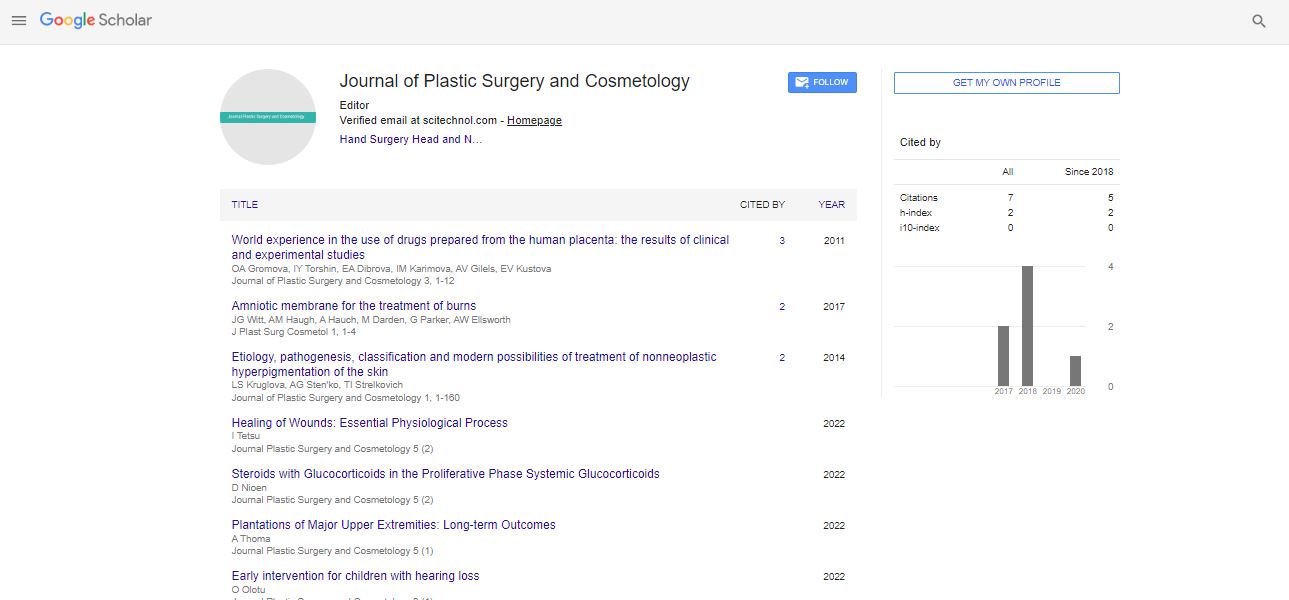Perspective, J Pls Sur Cos Vol: 12 Issue: 3
Pediatric Plastic Surgery: Nurturing Health and Happiness in Childhood
Edwin Wang*
1Department of Health Care, University of the Pacific, Stockton, California, US
*Corresponding Author: Edwin Wang,
Department of Health Care, University of
the Pacific, Stockton, California, USA
E-mail: Wang.edwin@uni.edu
Received date: 05 September, 2023, Manuscript No. JPSC-23-116717;
Editor assigned date: 07 September, 2023, PreQC No. JPSC-23-116717 (PQ);
Reviewed date: 21 September, 2023, QC No. JPSC-23-116717;
Revised date: 29 September, 2023, Manuscript No. JPSC-23-116717 (R);
Published date: 06 October, 2023 DOI: 10.4172/JPSC.100059.
Citation: Wang E (2023) Pediatric Plastic Surgery: Nurturing Health and Happiness in Childhood. J Pls Sur Cos 12:3.
Description
Pediatric plastic surgery is a distinct subspecialty within the broader field of plastic surgery, focusing on the surgical treatment of congenital, acquired, and developmental conditions in children. While the field shares similarities with adult plastic surgery, it requires a unique skill set, as the patients are often in the early stages of growth and development. Pediatric plastic surgery is more than just enhancing aesthetics; it is about improving a child's quality of life and selfesteem. The pediatric plastic surgery can be traced back to ancient civilizations, where early attempts to address congenital anomalies were documented. However, it was not until the 20th century that pediatric plastic surgery emerged as a formal subspecialty, with dedicated training programs and surgical techniques tailored to the specific needs of children. Pioneering surgeons played a vital role in advancing the field and developing innovative procedures.
Common pediatric plastic surgery procedures
Pediatric plastic surgery encompasses a wide range of procedures, addressing various congenital and acquired conditions. Some of the most common procedures include:
Cleft lip and palate repair: Cleft lip and palate are among the most common congenital anomalies, and surgical repair is typically performed during infancy and childhood to restore normal function and appearance.
Craniosynostosis correction: Craniosynostosis is the premature fusion of cranial sutures, which can lead to head shape abnormalities. Surgical correction is essential for normal brain development.
Ear reconstruction (Microtia repair): Microtia is a congenital condition in which the ear is underdeveloped or absent. Microtia repair involves the creation of a new ear from the patient's own tissue or synthetic materials.
Hemangioma and vascular anomaly treatment: Vascular anomalies, including hemangiomas and malformations, often require intervention to prevent complications and disfigurement.
Syndactyly and polydactyly correction: Congenital hand and foot anomalies such as webbed fingers (syndactyly) and extra fingers or toes (polydactyly) may require surgical correction to improve function and appearance.
Ethical considerations
Pediatric plastic surgery raises important ethical considerations, as it involves the treatment of minors. Key ethical principles in the field include the importance of informed consent from the child's guardians, respecting the child's autonomy when appropriate, and ensuring the best interests of the child are always paramount.
Recent advancements in pediatric plastic surgery
Advancements in pediatric plastic surgery have expanded treatment options and improved patient outcomes. These innovations include:
Minimally invasive techniques: Minimally invasive procedures, such as endoscopic surgery, have reduced scarring and recovery time for many pediatric plastic surgery procedures.
3D printing and imaging: 3D printing technology allows for precise modeling and surgical planning, enhancing surgical accuracy and outcomes.
Tissue engineering: Emerging tissue engineering techniques hold promise for creating custom grafts and implants, reducing the need for donor sites and improving graft acceptance.
Telesurgery: Telesurgery enables collaboration between surgeons across geographic distances, allowing for expert consultation and guidance during complex procedures.
Conclusion
Pediatric plastic surgery is a dynamic and vital field that positively impacts the lives of children and their families. From addressing congenital anomalies to treating acquired conditions, pediatric plastic surgeons provide comprehensive care that goes beyond aesthetics. The history of the field, common procedures, ethical considerations, and recent advancements highlight the compassion and expertise required to enhance the lives of young patients. As pediatric plastic surgery continues to advance, it is essential for surgeons and researchers to stay updated on the latest developments and to explore new avenues for improving patient care and quality of life.
 Spanish
Spanish  Chinese
Chinese  Russian
Russian  German
German  French
French  Japanese
Japanese  Portuguese
Portuguese  Hindi
Hindi 